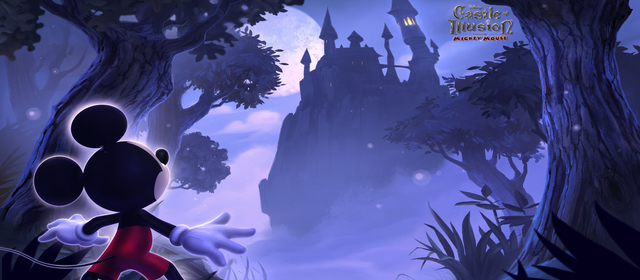Disney seem to be on somewhat of a retro kick lately, what with the recently-released DuckTales Remastered and now this – a re-imagining of classic MegaDrive title Castle of Illusion Starring Mickey Mouse. Of course, one of these was developed by Capcom and the other by SEGA, but Disney itself must have some interest in re-living the past glories of the company in video game form.
Whereas Duck Tales was exactly what it said on the box, a re-mastering complete with updated graphics and sound but maintaining the gameplay and level structure of the original, the developers who put together Castle of Illusion take a little more creative freedom with their game. Although many factors and features remain from the original 1991 game, SEGA Studios Australia have used that title as a jumping-off point.
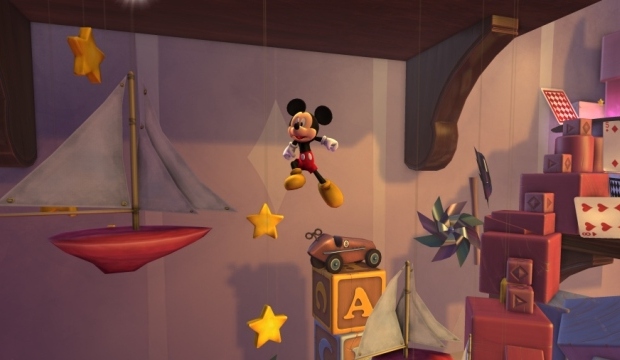
The story remains entirely the same, though, as our hero Mickey’s true love Minnie is kidnapped by the wicked Witch Mizrabel (the antagonist from Snow White), who wants to steal Minnie’s youth in order to restore her own. With that, Mickey sets out to rescue the damsel in distress and learns he must defeat several Masters of Illusion – creatures working for Mizrabel who guard the seven Rainbow Gems. Only with the seven gems can Mickey create the Rainbow bridge that will lead to Mizrabel’s tower, and his final battle.
Of course, the story wasn’t incredibly compelling when the game was first released, and it isn’t the most important factor this time around either. Although, it must be said that the narrative thread running through the game is much more coherent and successful than the first game. This is achieved largely through the use of short cutscenes and a narrator. The cutscenes vary from hand-drawn still images in a traditional Disney style, to fully 3D ones. These are all short, but help nudge the story along a little bit without becoming intrusive. But it is the ever-present narrator who leaves more of a mark on the game – for the better.
Firstly, he acts as a guide, introducing new levels as we reach them and giving a little idea of what to expect. He also commentates on proceedings as we go along, commiserating when something goes awry, but also adding in some humorous lines along the way. Because the delivery is so serious, it lends itself to a knowing, sardonic wit – and when the jokes do come they are largely pretty successful. Of course, if the player has to re-play sections they have failed repeatedly they will hear some of the same commentary repeated, but this isn’t much of an issue as this is the only time there is any repetition.
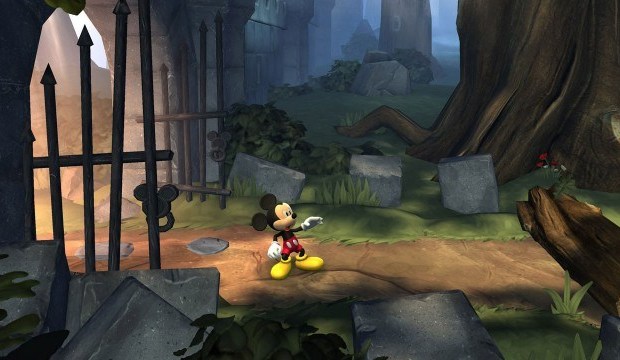
The basic gameplay has been left unchanged since the first game, but perhaps tweaked a little for modern audiences. Mickey can perform a regular jump, that suffices most of the time, but can also gain extra air by bouncing off the head of an enemy, to be propelled upward. Your main method of defeating bad guys is the good old noggin bounce, but players can also hurl apples and, later on, candles for a ranged attack, just as in the original game.
The levels also play out in similar ways, despite the general structure having been re-worked. You have to implement great timing and precision to make inch-perfect jumps and avoid enemy fire, falling platforms and other obstacles. Where the levels differ are the points where the game moves from 2D into 3D. You first encounter it when, after a short side-scrolling forest section, you arrive at the Castle world hub. Here you can freely explore in three dimensions. Other stages might see you casually walking in 2D, before a huge apple starts to chase you – a la Raiders of the Lost Ark – and the view switches to a face on chase, which is hugely reminiscent of the early Crash Bandicoot games.
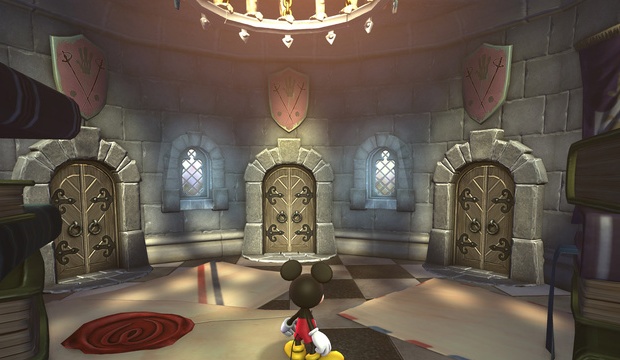
The third dimension is very cleverly used in the Clock Tower level, as part of a mirror-based puzzle. This is one of the few points in the game where the pace actually slows down from frantic to something a little more relaxed – albeit only for a few minutes. These sections are quite fun, but are really just short diversions from the two dimensional meat of the game, and that is no bad thing. The regular platforming sections have been built with a lot of care and planning, which results in some clever level design and some really taxing platform action.
This is especially the case when it comes to the in-game collectables. To progress through the Castle to more advanced levels Mickey must collect regular gems, of which there are many in each stage. You will easily be able to collect the minimum required, but if you want to collect everything and unlock Achievements or Trophies you’ll need to do a lot of trial and error and go back to re-play stages in order to find everything. Other collectables such as playing cards and Chilli peppers can be collected to unlock bonus costumes for Mickey, and these are even more well-hidden and harder to reach.
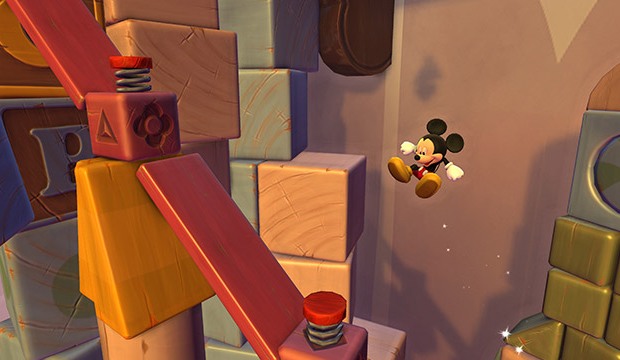
That brings me to the overall difficulty. This really isn’t a modern platform title in terms of difficulty. You start with only three stars – three hit points – and a handful of lives. Lose all of your hearts and you lose a life and must start a level from the beginning. There are few checkpoints across levels, but fortunately, falling in a hole will only result in losing one heart and returning to the last checkpoint – rather than losing a whole life. That is, unless you were already low on health. You can pick up extra stars in stages, but these are usually heavily-guarded or far out of reach, meaning gamers will often lose further stars trying to gain just one. It should also be said that the bosses in the game are quite simple – with clear patterns that can be learnt and avoided without too much difficulty.
Many bugbears of platform level design are also present in the game to challenge you. Water level? Check. Platforms that fall away seconds after landing on them? Check. Enemies re-spawning if you backtrack a few inches? Check. These are all frustrating, but aren’t necessarily design flaws – we have just become used to easier, more forgiving rules. In fact it is quite refreshing to be presented with a platform game where you have to think ahead, to experiment and plan the correct route to reach a bonus collectable that is in an awkward location. It is these things that add some life and longevity to the game – as the campaign easily completed in just a few hours, even if you struggle through some levels.
The presentation is probably what will catch your attention the most when starting the game. The high definition graphics have been lovingly created – drawn by artists with years of experience working with the famous mouse. All of the characters in-game, from Mickey himself to the Masters of Illusion, even down to the smallest of enemies, have been imbued with a lot of personality – each is animated beautifully and have their own little idiosyncrasies if you take the time to watch their animation cycles fully.
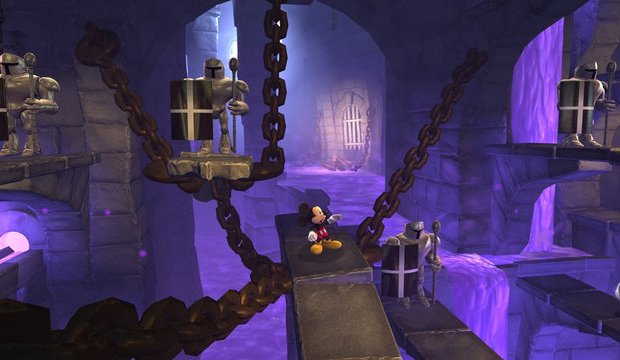
The worlds are multi-layered, even when in 2D, and there is a lot to take in – small touches that full the worlds with interesting things to look at. The only issue is that when in 3D modes it can be hard to see Mickey’s shadow, making it harder to judge your landings. This can really make 3D platformers quite tricky, and therefore the precise jumps in these sections can get irritating. The audio design is also very nicely put together, and the score brilliantly mixes orchestral versions of tunes from the original game with new, thoroughly Disney-like tunes.
VERDICT: Castle of Illusion does a commendable job of feeling both modern and old-fashioned at the same time. The game incorporates a lot of aspects from the MegaDrive game, but doesn’t constrict itself by trying to constantly imitate it. The game makes its own way, using the original as a road map. The audio-visuals are impressive, making full use of the expertise of Disney animators and artists to create an interactive cartoon. Unlike some re-makes that either change the game entirely or don’t change it enough, Castle of Illusion seems to find stood balance between the two.
Its only failing is its shortness – the title ends just when you’re getting really involved in the game. With only three stages in each world – one of those being a boss battle – a few extra levels would have been much appreciated, and as such the title just seems to rush by too quickly. It is a shame because its brevity results in it feeling a little disposable, despite all of its strengths. Castle of Illusion will cast a spell over you, but the magic will wear off all too soon.

VERY GOOD. An 8/10 is only awarded to a game we consider truly worthy of your hard-earned cash. This game is only held back by a smattering of minor or middling issues and comes highly recommended.


